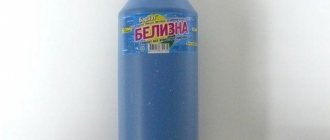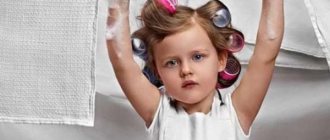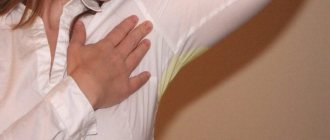When washing away stains of various origins, you may notice whitish or bluish marks of unknown origin on the fabric. Most likely, the reason why they occurred is simple - the cleaning agent used was not completely washed out of the fibers. Colored items suffer the most. To prevent such problems, wet cleaning recommendations should be followed. However, the traces that appear also need to be dealt with. Today’s publication will tell you how to remove powder stains on clothes and how to prevent their appearance.
Soap and vinegar
This is a very simple method that is suitable even for colored items. Don't be afraid, in small concentrations, vinegar is not at all dangerous. It's even used to set color!
How to use:
Add grated soap and a few tablespoons of vinegar to a bowl of warm water. Wash the fabric in this water and then rinse under running water. The smell can be removed with conditioner.
Note:
If you don’t have vinegar on hand, use a few tablespoons of soda. But it must be well dissolved. We recommend using laundry soap, but regular soap will work too.
Photo: shkolagolova.ru
Boiling water
Most often, bright blue or pink stains remain on light-colored clothes from improperly used washing powder. These stains can be removed in a less labor-intensive way than additional thorough rinsing.
If the composition of the fabric allows it to withstand high temperatures, simply boil water and pour it in a thin, neat stream onto the spot where the stain appears. Boiling water effectively removes stains and stains from powder, but only if very fresh traces appear. Old stains from detergents can only be removed by dry cleaning.
Ammonia
Another fairly well-known and widespread option among people.
How to use:
Dissolve 1 tsp. ammonia in two glasses of warm water. Wet the stain well with the mixture, leave for 5 minutes and wash.
Note:
This method works well for blue stains on white fabric, but for colored items, look for a more delicate method!
How to clean a silver chain at home: 10 effective ways
How to get rid of stains on a jacket after rain?
Salt solution also helps - 1 tbsp. a spoon diluted with water to a paste is applied to stains and stains for an hour, then the area is cleaned with a stiff brush and rinsed with water.
Interesting materials:
Is it possible to use polystyrene foam to insulate a bathhouse? Is it possible to use Penoplex for a bath? Is it possible to use Penoplex to insulate a steam room? Can white laundry powder be used for colored laundry? Is it possible to work out your abs if you have belly fat? Is it possible to glue paper-based wallpaper with non-woven glue? Is it possible to feed laying hens with broiler feed? Is it possible to paint wood with wall paint? Is it possible to paint the ceiling with wall paint? Is it possible to prune trees? When did the buds appear?
Rinse aid for colored items
Use a delicate method for multi-colored and black clothes. Just take a special mouthwash!
How to use:
Pour a cap of rinse aid into the basin, soak the clothes for 10 minutes and wash. At the end, be sure to rinse everything in clean water. Amounts may vary, so follow your detergent's instructions.
Note:
You can rinse things not by hand, but in a machine on a short cycle at 30 degrees.
How to clean a carpet at home?
The main reasons for the appearance of faded spots
Colored clothes may fade after washing. After
washing, different stains may appear on clothes: rusty brown, dark oil, yellow (on white shirts and sheets), dove, pink and red.
But most often white stains remain on dark clothes.
The following table will help you understand why things shed.
| Types of stains | Possible reasons for their appearance | How to prevent this problem from occurring |
| Colored stains on white linen | Washing multi-colored items at high temperatures. If white sheets and black socks were folded together, they will fade during the washing process, the sheets will be colored unevenly, and their whiteness will be irretrievably lost. | You need to put things of the same shade in the drum, wash light and dark fabrics separately, and when washing colored laundry, set the temperature to no higher than 40 degrees. |
| Red, rusty, brown spots | The presence of rust on the inner walls of the pipeline that supplies cold water to houses. | You need to install a filter on the cold water line. In old houses, experts advise installing two filters - coarse and fine. |
| Blue spots or purple stains on white linen | Choosing a powder with a color corrector. Some manufacturers add chemical or optical brighteners to the powders. They help mask yellowness and make laundry a tone lighter. But if a person exceeds the loading norm or uses the wrong temperature, the color corrector granules do not dissolve well and appear on light-colored clothes. | Buy a powder that does not contain blue or red granules. |
| White stains on dark clothes | Exceeding the dosage of the drug. It should correspond to the weight of the loaded laundry. If there is more powder than needed, stains will remain on dark T-shirts or trousers. They may appear if the machine is overloaded: due to dense compaction, clean water does not enter the “heart” of the coma. | Observe the powder loading dosage and do not overload the machine with laundry. |
| Yellow spots on silk, wool, down jackets, and other items made from delicate fabrics | Incorrectly selected washing powder, incorrectly set temperature. | Use liquid detergents and set the washing temperature indicated on the product label, refuse the spin mode, select an additional rinse mode. |
| Other spots | Things can get dirty when removing them from the drum when the owner takes them out with dirty hands. | Wash your hands before unloading the machine. |
The machine itself can dirty things if it has a dirty cuff, a moldy tray, or a clogged filter. Regular maintenance of equipment helps prevent the occurrence of such contaminants.
Lemon acid
Unlike vinegar, acid also smells nice, so you don't have to wash the smell out!
How to use:
Dissolve 1 tsp in a glass of hot water. acid and soak a cotton pad in the liquid. Apply to the stain for 10-15 seconds and gently wipe off so as not to damage the fabric. Rinse the area with running water.
Note:
Instead of citric acid, you can take oxalic acid. It’s much less common, but suddenly you just happen to have it lying around.
Photo: big-stirka.ru
How to Remove Powder Stains
Update date: 07/06/2020 12:00:16 7991 Share:
Author: Anastasia Berkovich
*Review of the best according to the editors of simplerule.ru. About the selection criteria. This material is subjective in nature, does not constitute advertising and does not serve as a purchase guide. Before purchasing, consultation with a specialist is required.
Washing powder is one of the most pleasant inventions of mankind. A few decades ago, the only way to get rid of stains on clothes was ash lye, laundry soap and ribbed washboards.
Nowadays, such boards remain only in museums (and the homes of young mothers who wash children’s clothes). And a huge number of different cleaning products have appeared on store shelves, promising to remove any stain from clothes, even the most difficult to remove, while maintaining color and softness.
But the washing powders themselves can also leave stains on clothes. After removing the laundry from the line, you can find white or blue stains on it. And they are caused precisely by washing powder.
Fortunately, such stains and stains can be removed even at home. You will need:
- Vinegar;
- Ammonia;
- Hydrogen peroxide;
- Lemon acid;
- Cotton swab;
- Bleach;
- Fabric softener for colored laundry.
Methods for removing powder stains
There are several ways to remove powder stains:
- Rinse the items several times in the washing machine. Or soak it in a basin for about forty minutes, and then rinse.
- If the first method does not help, then dilute a small amount of vinegar in water. Add laundry soap there. It can be cut into small pieces - this way the foam forms faster. Wash the item in the resulting solution. Vinegar will dissolve powder stains. Finish the procedure by rinsing either in a machine or under running water. If you don't mind the smell of vinegar, add conditioner. If you don’t have vinegar, you can replace it with ordinary baking soda, which leaves no odor.
- Dilute citric acid in hot water to form a paste. You need to moisten a cotton pad or swab in it. You need to wipe away the trace of the product until it disappears. Then rinse the item. Stains will disappear, plus a pleasant citrus aroma will emanate from the laundry.
- If white streaks appear on colored items, you can use a fabric softener. It must be mixed with plenty of water. Soak the items for fifteen to twenty minutes, then spend some time doing intensive hand washing. After this, your favorite clothes will look like new again.
- Items made from wool and other dense fabrics need to be washed a little differently. It is not recommended to use too high or low temperatures. The number of revolutions also decreases. This means that rinsing alone is not enough, and powder may remain on things in the form of traces and streaks. It is necessary to increase the number of rinses - three to four times will be enough. But if stains still remain, then you can use fabric softener for black linen.
Sometimes the marks are blue. The powder contains the substance indigo carmine, aniline dyes, which give blueness. If you do not act promptly, the item will be damaged. In this case, it is better to use the following home methods rather than dry cleaning services:
- When the laundry is completely dry, blue crystals may remain in the fibers of the fabric forever. Therefore, you should not hesitate, but immediately rinse things either in a washing machine or by hand, adding conditioner.
- If the item is colored, then rinsing it is allowed at temperatures up to fifty degrees. You don't have to use detergent.
- You can also use a stream of boiling water on the stain. But it is worth considering the type of fabric so as not to damage its structure. This method only works if the blue trace is completely fresh.
- For more delicate fabrics, a solution of vinegar, water and laundry soap is suitable. Such linen must be washed exclusively by hand.
- If blue spots have formed on white linen, a different approach is needed. One small mistake can result in the entire thing being painted in unpleasant shades of yellow, gray and blue. Therefore, powder manufacturers recommend choosing it according to its intended purpose.
Ways to deal with traces of blue on white:
- Dilute one teaspoon of ammonia in water. Treat the blue with this mixture until it disappears.
- If you have hydrogen peroxide in the house, add 70 ml to a small container of water. Apply the solution to the contaminated area, then leave for ten to fifteen minutes. There is no need to rinse, just gently rinse off the residue with water. Attention: this method is only suitable for white laundry. If peroxide gets on colored fabric, it risks discoloration.
- Take bleach and apply it only to stains or stains. Following the instructions on the package, wait the required amount of time, then rinse with running water.
Additional tips to help remove and prevent powder stains
- Choosing the right powder. Today, manufacturers offer a wide range of household chemicals. The main thing is to choose the right substance for the type of fabric. Many housewives have long preferred a gel detergent to granular powder. It is more economical, and you will be sure that things will look like new.
- Carefully study the proportions recommended by the manufacturer. They are on every package of washing powder. The more you add to the machine drum, the more likely it is to cause marks and stains. To be on the safe side, purchase a measuring cup, which will serve you well in the future.
- Try special capsules if you are afraid of incorrectly calculating the proportions of the product. They need to be placed not in a special compartment, but directly in the drum itself. Two capsules will be enough for a complete wash.
- If the fabric is made of dense material, it is better to increase the temperature. This will allow the product granules to dissolve faster.
- Do not use the powder for purposes other than intended for the type of laundry. Under no circumstances should snow-white items be washed with colored granules, and black items with white powder.
- Be sure to use fabric softeners and fabric softeners. They give the laundry softness, allowing the granules to dissolve and wash out faster.
- Nowadays you can often see household laundry chemicals marked “Universal”. But if you really value your things and time, it is better to buy products for certain types of laundry. If you want to use a universal powder, you should strictly follow the manufacturer’s instructions on the packaging.
- When washing by hand, it is advisable to change the water three to four times until it becomes completely clear. Some housewives purchase an ultrasonic washing machine. This baby doesn't take up much space. Using ultrasound, contaminants are separated from the fibers. No powder is needed here, just a rinse. If you are used to a pleasant aroma, then at the end of the wash you can add a little conditioner or fragrance.
- For delicate fabrics, it is better to use a gel detergent, since it is not advisable to exceed the temperature above thirty degrees. If you wash by hand, it is recommended to first dilute the washing powder in water, wait until it is completely dissolved, and then soak the laundry.
- In general, if you don’t want to try to remove difficult stains, then you should approach the choice of washing powder as responsibly as possible. This will help not only remove dirt, but also preserve the color and softness of the fabric.
Attention! This material is subjective in nature, does not constitute advertising and does not serve as a purchase guide. Before purchasing, consultation with a specialist is required.
Stain remover stick
They are sold anywhere: from underground passages and transport to supermarkets. If you usually pass by, it’s in vain. The product is truly working and versatile!
How to use:
Just use the pencil according to the instructions. Usually you need to rub it on the problem area, wait 10-15 minutes and rinse.
Note:
For white things there are the same bleaches in pencils.
How to clean an iron from burning at home?
Why does powder remain in the washing machine and not go away?
Why does the powder remain in the tray, although it should have been washed off with water into the laundry bin? When this happens for the first time, you need to check the following options:
- Is it normal to fill the washing machine with water? Turn the shut-off valve and check the inlet hose. Typically, if water does not get into the machine, it will not flush the powder out of the tray. Then the system displays a fault code on the display.
Open the dispenser tray and check whether the detergent is poured into the correct compartment. Please refer to the instruction manual.
- Turn off the tap and see if the water pressure is normal. If it is too weak, then it is not enough to flush the powder out of the dispenser. In this case, you need to wait until the supply resumes.
- If the powder partially leaves the tray, it is worth checking whether the channel through which water is flushed into the tank is clogged. The reason may also be a clogged mesh filter, which is located at the inlet of the water intake valve.
- Is the detergent used correctly? Look at the packaging to see how much product should be used normally. If there is too much powder, some of it remains in the cuvette.
- Poor quality powder also leads to flushing problems. Counterfeit products often stick to the walls and form clumps, preventing normal passage.
- Intake valve problems. If there is a blockage or breakdown, this leads to reduced water pressure or no water pressure.
Baking soda: a great stain remover
Using baking soda, you can remove almost any stain, including bluing. However, this product is very different from professional whitening products. It does not contain chemicals harmful to the human body. Baking soda can be used to remove stains from babies' clothes; it will not harm their health. In addition, white powder has a low cost, and is in the arsenal of almost every housewife.
To get rid of traces of blue on clothes, you need to perform the following manipulations:
- The contaminated product is laid out on a hard horizontal surface so that the stain is clearly visible.
- Afterwards, powder is poured onto the problem area and rubbed in well.
- The item is left for approximately 20 minutes.
- Afterwards, the remaining soda is removed using a brush with natural bristles.
- The product can be washed manually or in an automatic machine (it all depends on the manufacturer’s recommendations).
After this treatment, some things become a little rough. Vinegar will help restore them to their original appearance. This product is added to the final rinse water.
How to remove blue from clothes
This medication has a distinct blue color. And if it accidentally gets on your clothes, a bright spot appears, which can ruin the overall appearance of the product. At the same time, you shouldn’t be too upset, since using ordinary improvised means you can easily remove any contamination.
An excellent remedy in the fight against bright spots is hydrogen peroxide. It is recommended to use it only for processing light-colored items. Peroxide has a bleaching effect, which can cause even more damage to dark-colored items.
The liquid from the bottle is mixed with water in a 1:1 ratio. The item is placed in the resulting solution and left for approximately 30 minutes. Next, the clothes are washed in cold water. If traces of bluing remain, the procedure must be repeated, increasing the dose of peroxide.
From bleach
It all depends on where the unwanted spot is located. It is quite possible that the patch will look very natural on him. Nowadays a huge variety of them is offered in stores selling sewing supplies. As an option, paint over the stain with a special dye for denim or blue.
Here it is important to strictly follow the instructions so as not to completely ruin the item.
If the stain is too large, and even located in the most conspicuous place, in order not to throw the thing away, there is nothing left to do but repaint it a darker color.
You can turn blue jeans into spotted “varenki”, which were super popular in youth fashion in the 90s of the last century. Or boil the trousers until completely white.
You can use either liquid or powder bleach.
First you need to put a large pan of water on the fire. Add bleach to it (the dose is 2-3 times more than for regular washing with bleach). Meanwhile, twist the jeans into a tight rope. The more small folds there are on them, the more interesting the resulting pattern will be. The shape of the tourniquet should be secured somehow, for example, by tying it with strong twine. When the water boils, the jeans need to be lowered into it.
Cook, stirring with a long wooden stick. During the boiling process, it is important to carefully monitor how the denim changes color. When it reaches the expected saturation, the jeans need to be taken out immediately. Dumplings should be doused with cold water to cool slightly, then untied and rinsed well.
Then wash as usual.
How to remove stains and restore white color?
There are several ways to return radiant whiteness to plump clothes:
- Digestion with the addition of hydrogen peroxide. It is enough to dilute hydrogen peroxide (50 ml) in a liter of water and boil the faded white thing in the resulting solution for one hour.
- Treating stains with laundry soap. The faded areas are thoroughly rubbed with soap and the product is left for four hours, after which it is sent for re-washing.
- Treat stains with a mixture of citric acid, starch and salt. The components are mixed in equal proportions, water is added until it becomes a thick paste. The resulting composition is used to treat stains on faded clothing.
- Washing in potassium permanganate. Prepare a very weak solution of potassium permanganate (a few granules per 10 liters of water are enough), in which the dyed item is soaked for twenty minutes. Afterwards, the product is rinsed and washed again as usual.
The method of soaking in potassium permanganate is used as a last resort, since a miscalculation in the number of granules used can completely ruin the faded item.
Basic rules for removing ink
Ink in fountain pens, seals or stamps is made on a water-glycerin base or a dispersed medium with a solvent and alcohol. Contains a colored pigment that is insoluble in water. Ink tends to penetrate firmly and quickly into various surfaces (it has strong adhesion to materials), which is why it is so difficult to get rid of. Conventional detergents (soap, powder, washing gel) cannot remove them - it is necessary to use substances that dissolve the base and pigment.
Most fountain pen inks are water-soluble, so contact with water can cause the ink to spread across the surface. Therefore, it is not recommended to wet clothes stained with ink.
Rules to follow:
- Sprinkle the ink stain with starch, crushed chalk or talcum powder. The powder will not only absorb part of the pigment, but will also prevent it from spreading.
- Before washing, be sure to remove any dirt, otherwise the ink will spread across the surface of the clothing.
- It is advisable to remove spilled ink from clothing immediately. Old traces are much more difficult to remove.
- Clean the contaminated area from the edges to the center. This will help avoid divorces. To prevent them, you can also sprinkle talc or starch around the edges of the blots.
- When removing an ink blot, place a napkin or rag folded several times under the area of fabric being treated. This rule must be followed when removing stains from trousers or sleeves of clothing, otherwise an ink print will appear on the other side.
- First test the cleaning product on an inconspicuous area of clothing. If the color of the fabric or its structure has not changed, you can use it to clean clothes.
- When applying cleaning products that dissolve the dye in ballpoint pens, there is no need to wait - the stain must be removed immediately, without allowing the solvent to dry.
- When removing contamination with aggressive agents, you should use gloves and a respirator. Protect children and allergy sufferers from inhaling these substances. It is advisable to carry out the treatment with an open window or in the fresh air.
Compliance with these rules will protect clothes from damage during processing and maintain health.
Re-wash
Have you tried to manually remove the consequences of an unsuccessful down jacket wash? Did you manage to wash something off, but some traces remain? It's a shame, but I'll have to wash it again.
- Replace the powder with gel and take in smaller quantities than you used the first time.
- Add oxygen stain remover.
- Set the machine to gentle mode. As for wool.
- Do not overload the washing machine drum. Turn the down jacket inside out and button it up.
- It is better to use an additional rinse.
- Dry horizontally, on a flat surface, so that there is no deformation and no smudges form.
How to prevent scale formation?
One of the most effective ways is to use special filters. They can be installed directly on the inlet hose of the washing machine or on the entire pipeline of the apartment. Filters retain most microelements, including calcium, iron, and magnesium, which are so harmful to equipment components. The product is effective, but quite expensive. In addition, filters will have to be changed periodically.
Proper washing will also help reduce the amount of scale:
- The more intense the program, the hotter the water used to wash clothes. Because of this, plaque forms much faster. In most cases, 40, maximum 50 degrees is enough to remove all dirt. Delicate programs do not require washing at temperatures above 30. Also in modern technology there are special programs that provide good results when washing in lukewarm or even cold water (for example, Eco Bubble from Samsung).
- After the program ends, the laundry must be removed. The presence of washed clothes in the machine will lead to the appearance of fungus, mold, and various deposits on the surfaces of the equipment. Need to go away and get clean things when you return? Use the delay start function (if available).
- Ventilate the machine regularly and wipe its walls with a soft, dry cloth. This will extend the service life of the equipment.











